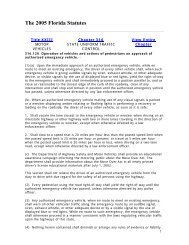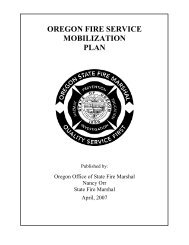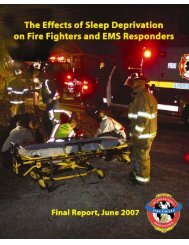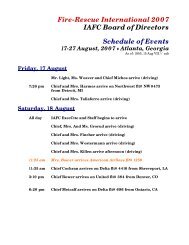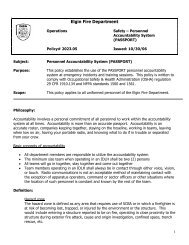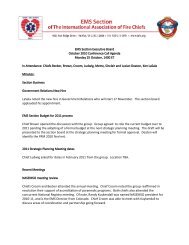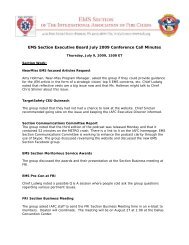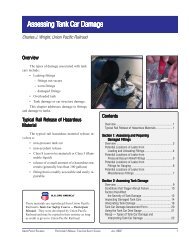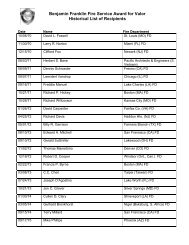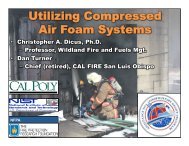Understanding Fireground LODDS - International Association of Fire ...
Understanding Fireground LODDS - International Association of Fire ...
Understanding Fireground LODDS - International Association of Fire ...
Create successful ePaper yourself
Turn your PDF publications into a flip-book with our unique Google optimized e-Paper software.
A fresh perspective on an old problem<br />
BY JARRET BYRNE<br />
Editor’s Note: While <strong>Fire</strong>Rescue usually publishes articles from fire<br />
service veterans, we felt our readers would be interested in this perspective<br />
from a young firefighter on a critical issue.<br />
Author’s Note: This article is a shorter version <strong>of</strong> the thesis I presented<br />
to the faculty at Worcester State College. My firefighting<br />
experience includes 5 years as a call firefighter/EMT in Boylston,<br />
Mass. I joined the department when I was 17 after a family friend<br />
who was an FDNY firefighter was killed on 9/11.<br />
Although I may not have the experience <strong>of</strong> a 20-year fire service<br />
veteran, I do possess the same dedication, and I wanted to apply the<br />
skills I had learned in college to the job I love. This article is the culmination<br />
<strong>of</strong> countless hours spent reading entries in the USFA’s<br />
Flashovers are<br />
becoming an<br />
increasing hazard<br />
on the fireground.<br />
As a result, they are<br />
one <strong>of</strong> the five<br />
major causes <strong>of</strong><br />
fireground LODDs.<br />
<strong>Fire</strong>fighters Memorial Database and associated NIOSH reports. It<br />
is my belief that the best way to remember those who died in the<br />
line <strong>of</strong> duty is to make the cultural changes necessary to prevent<br />
future tragic deaths.<br />
In 2004, fire service leaders and equipment manufacturers<br />
met in Tampa, Fla., to establish a plan to reduce firefighter<br />
line-<strong>of</strong>-duty deaths (LODDs) by 25 percent every 5 years.<br />
Deemed the <strong>Fire</strong>fighter Life Safety Summit, the 200 assembled<br />
members created 16 life safety initiatives to achieve this goal.<br />
The <strong>Fire</strong>fighter Life Safety Summit Initial Report states: “This<br />
is the first step along a path that will require a huge commitment<br />
<strong>of</strong> energy and resources over several years.” 1<br />
▲<br />
PHOTO MIKE COPPOLA<br />
R E P R I N T E D W I T H P E R M I S S I O N O F E L S E V I E R P U B L I C S A F E T Y © 2 0 0 7
PHOTOS COURTESY NIOSH<br />
UNDERSTANDING FIREGROUND <strong>LODDS</strong><br />
Above: Entanglement hazards<br />
like this one abound on the fireground;<br />
five firefighters died<br />
between 1999 and 2004 from<br />
entanglements.<br />
Right: Structural failure and collapse<br />
contributed to 43 percent<br />
<strong>of</strong> fireground deaths between<br />
1999 and 2004.<br />
For firefighters operating on the fireground, however,<br />
several years is too long to wait. On average, 15<br />
non-cardiac fireground fatalities occur each year. To<br />
prevent this trend from continuing, we must identify<br />
the factors that lead to fireground LODDs.<br />
THE 5 FACTORS<br />
Over the 5-year period beginning in 1999 and ending<br />
in 2004, 75 firefighters died in the line <strong>of</strong> duty from<br />
either trauma or smoke inhalation while operating at<br />
structure fires. Of those 75 deaths, 32 can be attributed<br />
directly to some form <strong>of</strong> catastrophic structural collapse.<br />
That’s 43 percent <strong>of</strong> the 75 total deaths.<br />
Structural failures not only claimed the lives <strong>of</strong> firefighters<br />
working within structures, but also the lives <strong>of</strong> four<br />
firefighters working outside <strong>of</strong> structures but within the<br />
collapse zone. All four <strong>of</strong> those firefighters were <strong>of</strong>ficers.<br />
The majority (18) <strong>of</strong> these collapses occurred at residential<br />
structures; eight occurred on commercial properties,<br />
mostly stores and <strong>of</strong>fices. It’s also important to<br />
note that all six <strong>of</strong> the deaths that took place on public<br />
assembly property, such as churches and community<br />
halls, were caused by collapses.<br />
The four remaining causes are not mutually exclusive,<br />
but they do present recognizable, and therefore<br />
correctable, issues. The worst <strong>of</strong> these factors over the<br />
past 5 years has been firefighter disorientation, directly<br />
contributing to the deaths <strong>of</strong> 24 firefighters, or 32 percent<br />
<strong>of</strong> fireground fatalities. Disorientation has been a<br />
significant problem since the fire service first began<br />
entering burning structures to extinguish fires and rescue<br />
trapped civilians. More than 100 years later, it’s<br />
still a leading cause <strong>of</strong> fireground deaths. As is the case<br />
with collapses, the majority <strong>of</strong> disorientation fatalities<br />
(13) occurred at residential structures. Eleven disorientation<br />
deaths happened on commercial properties,<br />
and two occurred on industrial properties.<br />
Another contributing event: emergency evacuations,<br />
which led to 11 deaths, or 15 percent <strong>of</strong> the total.<br />
These situations are particularly saddening, because<br />
the incident commander (IC) has reevaluated the risks<br />
and benefits <strong>of</strong> having crews work within a structure<br />
and decided, for their safety, to pull them out.<br />
Unfortunately, an individual or a crew fails to completely<br />
vacate the structure. What should have been a<br />
life-saving initiative on the part <strong>of</strong> the IC now<br />
becomes a life-saving operation for everyone else on<br />
the fireground. A lack <strong>of</strong> adequate accountability contributes<br />
to and compounds unsafe evacuations. Over<br />
the past 5 years, six firefighters have lost their lives<br />
while evacuating commercial structures; five have lost<br />
their lives evacuating residential structures.<br />
The fourth factor is an exponentially growing threat<br />
on the fireground: flashovers, which killed six firefighters,<br />
or 8 percent <strong>of</strong> the total fireground LODDs<br />
between 1999 and 2004. According to the “Essentials<br />
<strong>of</strong> <strong>Fire</strong> Fighting, 4 th Edition,” a flashover is “the transition<br />
between the growth and the fully developed fire<br />
stages … the fire changes from one that is dominated<br />
by the burning <strong>of</strong> the materials first ignited to one that<br />
involves all <strong>of</strong> the exposed combustible surfaces within<br />
the compartment.” 2 Essentially, a flashover is the point<br />
where enough heat builds up within a space to ignite<br />
all materials inside that space, including victims and<br />
firefighters. All six flashover deaths occurred within<br />
residential structures.<br />
The final direct cause <strong>of</strong> fireground LODDs: entanglement.<br />
Five trapped, caught or entangled firefighters<br />
perished in 5 years—7 percent <strong>of</strong> all the fireground<br />
deaths. Entanglement is an unavoidable issue when<br />
operating in structures, since wires abound in modern<br />
buildings and smoke conditions obscure hazards.<br />
Tools, limbs, bunker gear and SCBAs—items that normally<br />
protect firefighters— are all potential entanglement<br />
hazards. Debris, furniture and structural<br />
elements are also capable <strong>of</strong> entangling or entrapping<br />
firefighters working within a structure. Of the five firefighters<br />
killed as a result <strong>of</strong> entanglement, three died in<br />
commercial structures and two in residential structures.<br />
THE SOLUTIONS<br />
Although the fireground is an inherently dangerous<br />
place to work, it doesn’t need to be deadly. Through<br />
training, research and more training, firefighters and<br />
their <strong>of</strong>ficers can become aware <strong>of</strong> warning signs and<br />
proactively prevent potentially life-threatening scenarios.<br />
With the five major contributing factors in fireground<br />
LODDs identified, it’s possible to work toward<br />
solutions today that will ensure everybody goes home<br />
tomorrow. Let’s look at some solutions for each <strong>of</strong> the<br />
factors separately.<br />
▲<br />
R E P R I N T E D W I T H P E R M I S S I O N O F E L S E V I E R P U B L I C S A F E T Y © 2 0 0 7
UNDERSTANDING FIREGROUND <strong>LODDS</strong><br />
Collapse<br />
Preventing deaths associated with collapse<br />
requires knowledge and communication. All<br />
firefighters, whether volunteer or career, must<br />
know and understand building construction.<br />
Everyone operating on the fireground must be<br />
aware <strong>of</strong> the fact that buildings built with<br />
trusses will catastrophically fail under fire conditions<br />
in a short amount <strong>of</strong> time. Type I, or<br />
fire-resistive, construction will remain more<br />
structurally sound during a fire due to its reinforced<br />
construction, as opposed to Type V, or<br />
wood-frame, construction. 3 Training is key to<br />
understanding and recognizing elements <strong>of</strong><br />
building construction.<br />
Additionally, firefighters must recognize<br />
warning signs <strong>of</strong> structural instability, including,<br />
but not limited to, “cracks or separation<br />
in walls, floors, ceilings, and ro<strong>of</strong> structures …<br />
evidence <strong>of</strong> existing structural instability …<br />
loose bricks, blocks, or stones … deteriorated<br />
mortar between the masonry … [and] prolonged<br />
fire exposure to the structural members.”<br />
4 All <strong>of</strong> this information must be<br />
included in the IC’s risk-benefit analysis,<br />
which must be constantly reevaluated. When<br />
firefighters see these signs <strong>of</strong> collapse, interior<br />
firefighting becomes far too great a risk.<br />
Disorientation<br />
Training can also combat disorientation.<br />
Departments can easily create scenarios that<br />
require firefighters to navigate situations while<br />
blindfolded and wearing full personal protective<br />
equipment (PPE). They can learn to use<br />
walls and hoselines to keep themselves oriented<br />
when visibility is masked. Mazes help<br />
build firefighter confidence in similar situations<br />
by placing them in a disorienting environment<br />
where they can learn safely. Many<br />
fire departments now have ropes and thermal<br />
imagers at their disposal as well, but such tools<br />
are useful only if department personnel are<br />
properly trained in their use and function. An<br />
hour <strong>of</strong> familiarization at the firehouse can<br />
potentially save a life later.<br />
<strong>Fire</strong>fighters must also be trained to always<br />
operate on the buddy system as a crew, and<br />
each crew should be required to have a functioning<br />
radio they know how to use. Crews<br />
help eliminate disorientation, but in the event<br />
that a crew becomes lost, they should be<br />
encouraged to call in a mayday (for more on<br />
maydays, see “Mayday 101,” p. 168).<br />
Emergency Evacuations<br />
The problem <strong>of</strong> emergency evacuations is<br />
born out <strong>of</strong> a breakdown in crew integrity and<br />
poor accountability. Cohesive crews not only<br />
reduce disorientation, but they also look out<br />
for one another. Eliminating freelancing will<br />
improve the chances all personnel are aware <strong>of</strong><br />
the all-out order, and ensure no individual goes<br />
missing. In the event that an individual does go<br />
missing, however, an accountability system,<br />
along with a personnel accountability report<br />
(PAR) following the evacuation, will identify<br />
those individuals or crews who have failed to<br />
exit the building. The quicker this information<br />
becomes available, the quicker an in-place<br />
rapid intervention team (RIT) can enter the<br />
structure and rescue those individuals.<br />
<strong>Fire</strong>fighters should be reminded that evacuations<br />
are not races, nor are they panic situations.<br />
They must be controlled and orderly.<br />
As with all LODD causes, training is essential<br />
to ensure emergency evacuations happen<br />
as needed. <strong>Fire</strong>fighters can train on RIT operations<br />
and on how to self-extricate from hazardous<br />
situations.<br />
Flashovers<br />
Flashovers are an increasing fact <strong>of</strong> life for fire<br />
departments and personnel. As developers<br />
design and build homes that hold in more and<br />
more heat, and as alerting devices become<br />
quicker, cheaper and more readily available,<br />
firefighters will find themselves responding to<br />
more and more structures that have not yet<br />
flashed or self-vented. Where once a single<br />
panel <strong>of</strong> glass may have blown out, newer<br />
double- and triple-paned windows turn buildings<br />
into ovens.<br />
But firefighters and <strong>of</strong>ficers can predict and<br />
prevent flashovers. Proper ventilation and<br />
effective communication between ladder and<br />
engine crews can alleviate the build-up <strong>of</strong> heat<br />
before the room flashes. Engine and ladder<br />
personnel must work together, since ventilation<br />
and extinguishment are coordinated<br />
activities. Proper ventilation will also increase<br />
visibility and allow engine crews to get closer<br />
to the fire, making extinguishment easier.<br />
Once again, training plays a key role.<br />
Personnel should be trained to recognize the<br />
warning signs <strong>of</strong> a flashover, such as thick<br />
smoke that is pulled down only to rise back<br />
up, pockets <strong>of</strong> fire burning in the smoke and<br />
unusually intense heat. <strong>Fire</strong>fighters should also<br />
check the atmosphere periodically by sending<br />
a small burst <strong>of</strong> water to the ceiling. Water that<br />
does not return has encountered extreme heat<br />
and vaporized. Finally, any department that<br />
has access to a flashover training simulator<br />
should use it. There, firefighters can observe a<br />
flashover without getting hurt, better preparing<br />
them for conditions they may encounter<br />
at real fires.<br />
▲<br />
R E P R I N T E D W I T H P E R M I S S I O N O F E L S E V I E R P U B L I C S A F E T Y © 2 0 0 7
UNDERSTANDING FIREGROUND <strong>LODDS</strong><br />
Two firefighters were<br />
injured and one firefighter<br />
lost his life<br />
when this home<br />
flashed over.<br />
PHOTO COURTESY NIOSH<br />
Entanglement<br />
Entanglement is an individual issue that becomes the<br />
concern <strong>of</strong> the entire crew and the IC when conditions<br />
deteriorate. The most important thing to remember in<br />
an entanglement scenario is to remain calm. Like everything<br />
else in the fire service, this can be achieved<br />
through training. As part <strong>of</strong> disorientation training,<br />
instructors can slip ropes over participants’ SCBAs to<br />
simulate hanging wires, requiring that they dislodge<br />
themselves. Additionally, firefighters should be able to<br />
operate all parts <strong>of</strong> their SCBA and effectively manage<br />
all tools in blinding conditions while remaining calm.<br />
Some firefighters carry wire cutters in their bunker gear,<br />
but like any other tool, cutters are only as effective as the<br />
time spent training with them. With some simple training<br />
exercises, cohesive crews, in-place RITs and effective<br />
radio communications, deaths as a result <strong>of</strong> entanglement<br />
can be eliminated from the fireground.<br />
CHANGE BEGINS WITH EACH OF US<br />
<strong>Fire</strong> departments have always been as successful as the<br />
sum <strong>of</strong> their parts. Dedicated, well-trained and educated<br />
firefighters and <strong>of</strong>ficers are capable <strong>of</strong> so much<br />
more than departments that have not made training a<br />
priority. Most fireground LODDs can be eliminated if<br />
every firefighter makes a point to practice safe techniques.<br />
When one firefighter fails to be safe, every firefighter<br />
suffers the consequences.<br />
The first <strong>of</strong> the 16 life safety initiatives speaks <strong>of</strong> a cultural<br />
change within the fire service, and that change<br />
begins in the hearts and minds <strong>of</strong> all firefighters, from<br />
the chiefs to the recruits.<br />
Jarret Byrne has served as a call firefighter/EMT in Boylston, Mass., since<br />
2002. He attended night classes at the Massachusetts <strong>Fire</strong>fighting Academy<br />
in 2004–2005 while attending full-time classes at Worcester State College.<br />
He earned his <strong>Fire</strong>fighter I/II certification in summer 2005. Currently he is<br />
studying in Washington, D.C.; he will graduate in May. Byrne can be reached<br />
at jbyrne@worcester.edu.<br />
NOTES<br />
1<br />
National Fallen <strong>Fire</strong>fighters Foundation, “<strong>Fire</strong>fighter Life<br />
Safety Summit Initial Report”; www.everyonegoeshome.<br />
org/pdf/Summit%20Reports/Initial_Summit_Report.pdf.<br />
2,3,4<br />
<strong>International</strong> <strong>Fire</strong> Service Training <strong>Association</strong>,<br />
“Essentials <strong>of</strong> <strong>Fire</strong>fighting, 4 th Edition.” Oklahoma: <strong>Fire</strong><br />
Protection Publications, 1998; p. 49, 65–67, and<br />
73–74, respectively.<br />
R E P R I N T E D W I T H P E R M I S S I O N O F E L S E V I E R P U B L I C S A F E T Y © 2 0 0 7



